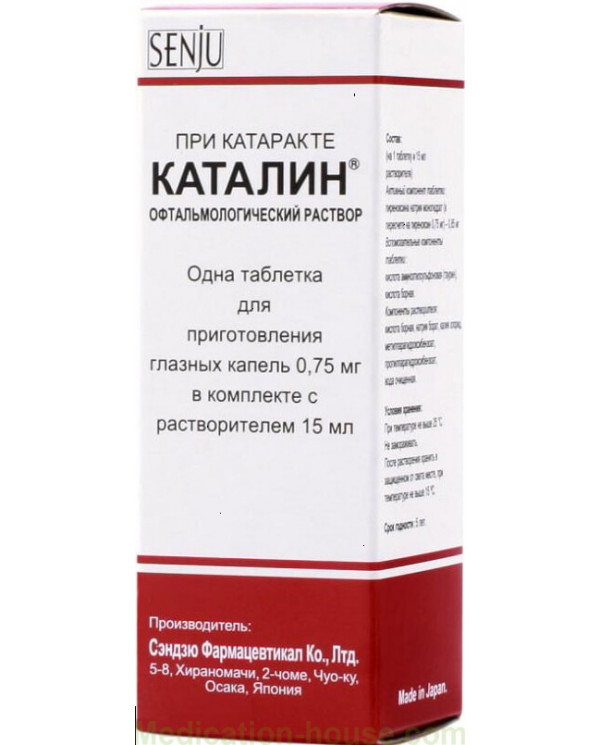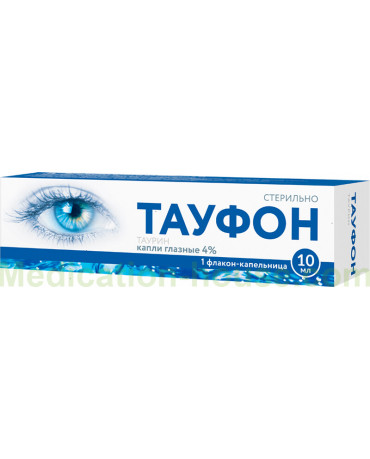Instruction for use of Catalin
You can buy Catalin on this page
The systematic use of Catalin helps to normalize the nutrition of the visual organ and prevent the accumulation and deposition of solid compounds in its tissues.
Release form
Catalin, unlike other ophthalmic drops, is prepared from a tablet and a solvent, which are sold in a set.
Thus, the drug Catalin is packed in cardboard boxes, inside which there is a blister with one tablet (0.75 mg) and a plastic bottle (15 ml) with a solution.
Catalin tablets are bright in color, they are yellow, orange, red. When they are dissolved in an isotonic liquid, the finished drops take on the same color.
The droplet bottle has a dispenser for accurate instillation.
Composition
The main active ingredient of the drug is pyrenoxine.
The preparation contains boric and aminoethylsulfonic acids as preservatives.
In order to prepare drops, the tablet is dissolved in sterile isotonic liquid, which contains: methylparaben, propylparaben, sodium borate.
Act
The drug improves the trophic properties of the cell membranes of the eye tissues and activates metabolism in them. It also inhibits the formation of solid protein structures in the lens.
Indeed, the reason for its change is the transformation of liquid protein fractions (proteins) into insoluble ones, therefore its initial physiological property (transparency) is partially or completely lost.
Catalin, on the other hand, inhibits the development of such pathological processes by inhibiting quinone elements, and this property is a mechanism that slows down the development of opacity in patients with cataracts.
Thus, the use of drops helps to activate the work of proteolytic enzymes, which are able to preserve the natural properties of the structures of the lens, as well as accelerate the process of removing free radicals from the intercellular space, that is, free the eyes from toxic substances.
The maximum saturation of the lens tissues with Catalin occurs 4 hours after instillation, the drug is excreted through the kidneys practically unchanged.
Indications for use
Senile cataract.
Diabetic cataract.
Ophthalmologists prescribe the eye drops as one of the leading agents in complex therapy and as a preventive treatment at the initial stages of degenerative changes in the structure of the lens.
Instructions
Preparation
With clean hands, open the package with a tablet, place it in a bottle with a solvent, which is vigorously shaken several times. The result should be a homogeneous solution.
Using
The resulting medicine is instilled into the conjunctiva, 1-2 drops, from 1 to 5 times a day.
Therapy course
Treatment takes from two weeks to a month, it can be repeated, but at least after a 7-14 day break.
Storage
The ready-made solution can be used within 20 days, and at the end of this period it is considered unusable.
In order to avoid infection of drops with pathogenic microflora, the cap of the dropper bottle must be screwed tightly, it is advisable not to touch its nose with hands, eyelashes, eyelids.
The drug should be stored in a dark and cool place (at a temperature not exceeding 15 degrees), out of the reach of children.
The shelf life of unopened Catalin is 5 years.
Recommendations
It is impossible to combine Catalin therapy with eye drops based on silver or zinc, a chemical reaction occurs between them, which changes the composition of the drugs.
Before instilling Catalin, those people who use contact lenses need to take them off and put them on 10-15 minutes after the procedure.
Contraindications
Allergies
Inflammatory eye diseases
Pregnancy, lactation
Childhood.
Adverse reactions
They are of an incoming nature and disturb patients within a few minutes after instillation of drops.
Often observed:
burning, stinging and itching;
hyperemia and edema of the conjunctiva (redness);
lacrimation;
development of keratitis (inflammation of the cornea), blepharitis (inflammation of the edge of the eyelid).
Reviews
Olga Konstantinovna, 68 years old:
I used Catalin as soon as my cataract was diagnosed, I used it constantly, as prescribed by the doctor. The cataract did not grow and the vision was preserved. I don’t want surgery, I’m afraid for the pressure and heart, so these drops periodically “settle” in my medicine cabinet. Of the minuses - an unpleasant burning sensation and tingling sensation in the eyes immediately after instillation.
Alexey Petrakov, 49 years old:
I am a diabetic so I have a clouded lens. I am treated by an endocrinologist and an ophthalmologist, Catalin is only one of the means that I instill in my eyes.
So far, in combination with other drugs and insulin, the dynamics are stable. I do not like redness of the eyes and tears after applying the drops.
Terms of sell
You can buy Catalin without a prescripiton from a doctor.


